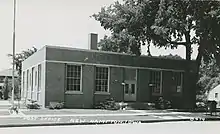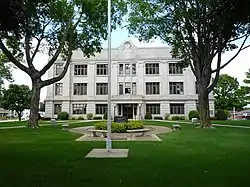New Hampton, Iowa | |
|---|---|
 | |
 Location of New Hampton, Iowa | |
| Coordinates: 43°3′35″N 92°18′53″W / 43.05972°N 92.31472°W | |
| Country | |
| State | |
| County | Chickasaw |
| Area | |
| • Total | 3.36 sq mi (8.69 km2) |
| • Land | 3.35 sq mi (8.68 km2) |
| • Water | 0.00 sq mi (0.01 km2) |
| Elevation | 1,158 ft (353 m) |
| Population (2020) | |
| • Total | 3,494 |
| • Density | 1,042.36/sq mi (402.45/km2) |
| Time zone | UTC-6 (Central (CST)) |
| • Summer (DST) | UTC-5 (CDT) |
| ZIP codes | 50659, 50661 |
| Area code | 641 |
| FIPS code | 19-56100 |
| GNIS feature ID | 0459473 |
| Website | www |

New Hampton is a city in, and the county seat of, Chickasaw County, Iowa, United States. The population was 3,494 at the time of the 2020 census.[2]
History
New Hampton was founded circa 1855. It is named after New Hampton, New Hampshire, the native town of one of its founders.[3]
Geography
New Hampton is located at 43°3′35″N 92°18′53″W / 43.05972°N 92.31472°W (43.059701, -92.314703).[4]
According to the United States Census Bureau, the city has a total area of 3.16 square miles (8.18 km2), all land.[5]
Climate
| Climate data for New Hampton, Iowa (1991–2020 normals, extremes 1897–present) | |||||||||||||
|---|---|---|---|---|---|---|---|---|---|---|---|---|---|
| Month | Jan | Feb | Mar | Apr | May | Jun | Jul | Aug | Sep | Oct | Nov | Dec | Year |
| Record high °F (°C) | 61 (16) |
65 (18) |
84 (29) |
94 (34) |
105 (41) |
105 (41) |
110 (43) |
104 (40) |
101 (38) |
95 (35) |
78 (26) |
64 (18) |
110 (43) |
| Mean daily maximum °F (°C) | 23.3 (−4.8) |
27.8 (−2.3) |
41.0 (5.0) |
56.3 (13.5) |
68.0 (20.0) |
78.0 (25.6) |
80.8 (27.1) |
78.8 (26.0) |
72.6 (22.6) |
59.1 (15.1) |
42.8 (6.0) |
29.1 (−1.6) |
54.8 (12.7) |
| Daily mean °F (°C) | 14.4 (−9.8) |
18.8 (−7.3) |
31.7 (−0.2) |
45.2 (7.3) |
57.2 (14.0) |
67.5 (19.7) |
70.5 (21.4) |
68.4 (20.2) |
61.0 (16.1) |
48.0 (8.9) |
33.3 (0.7) |
20.8 (−6.2) |
44.7 (7.1) |
| Mean daily minimum °F (°C) | 5.5 (−14.7) |
9.8 (−12.3) |
22.4 (−5.3) |
34.1 (1.2) |
46.5 (8.1) |
56.9 (13.8) |
60.2 (15.7) |
58.0 (14.4) |
49.3 (9.6) |
36.9 (2.7) |
23.8 (−4.6) |
12.4 (−10.9) |
34.6 (1.4) |
| Record low °F (°C) | −34 (−37) |
−33 (−36) |
−25 (−32) |
5 (−15) |
20 (−7) |
34 (1) |
41 (5) |
35 (2) |
19 (−7) |
0 (−18) |
−14 (−26) |
−29 (−34) |
−34 (−37) |
| Average precipitation inches (mm) | 1.31 (33) |
1.38 (35) |
2.35 (60) |
4.18 (106) |
4.95 (126) |
6.59 (167) |
4.99 (127) |
4.59 (117) |
3.83 (97) |
2.66 (68) |
2.07 (53) |
1.67 (42) |
40.57 (1,030) |
| Average snowfall inches (cm) | 9.7 (25) |
10.3 (26) |
6.2 (16) |
1.4 (3.6) |
0.0 (0.0) |
0.0 (0.0) |
0.0 (0.0) |
0.0 (0.0) |
0.0 (0.0) |
0.1 (0.25) |
2.9 (7.4) |
7.9 (20) |
38.5 (98) |
| Average precipitation days (≥ 0.01 in) | 6.2 | 5.5 | 7.3 | 9.3 | 10.9 | 10.0 | 7.8 | 7.7 | 7.5 | 6.8 | 5.4 | 6.2 | 90.6 |
| Average snowy days (≥ 0.1 in) | 4.5 | 4.0 | 2.3 | 0.7 | 0.0 | 0.0 | 0.0 | 0.0 | 0.0 | 0.1 | 1.6 | 4.2 | 17.4 |
| Source: NOAA[6][7] | |||||||||||||
Demographics
| Year | Pop. | ±% |
|---|---|---|
| 1870 | 455 | — |
| 1880 | 1,105 | +142.9% |
| 1890 | 1,314 | +18.9% |
| 1900 | 2,339 | +78.0% |
| 1910 | 2,275 | −2.7% |
| 1920 | 2,539 | +11.6% |
| 1930 | 2,458 | −3.2% |
| 1940 | 2,933 | +19.3% |
| 1950 | 3,323 | +13.3% |
| 1960 | 3,456 | +4.0% |
| 1970 | 3,621 | +4.8% |
| 1980 | 3,940 | +8.8% |
| 1990 | 3,660 | −7.1% |
| 2000 | 3,692 | +0.9% |
| 2010 | 3,571 | −3.3% |
| 2020 | 3,494 | −2.2% |
| Source: "U.S. Census website". United States Census Bureau. Retrieved March 29, 2020. Source: | ||
2010 census
As of the 2010 census,[9] there were 3,571 people, 1,555 households, and 943 families living in the city. The population density was 1,130.1 inhabitants per square mile (436.3/km2). There were 1,697 housing units at an average density of 537.0 per square mile (207.3/km2). The racial makeup of the city was 96.0% White, 0.3% African American, 0.1% Native American, 0.5% Asian, 2.5% from other races, and 0.4% from two or more races. Hispanic or Latino of any race were 3.9% of the population.
The median age in the city was 44.8 years. 22.9% of residents were under the age of 18; 6.7% were between the ages of 18 and 24; 20.6% were from 25 to 44; 26.8% were from 45 to 64; and 23% were 65 years of age or older. The gender makeup of the city was 47.4% male and 52.6% female.
2000 census
As of the 2000 census,[10] there were 3,692 people, 1,545 households, and 976 families living in the city. The population density was 1,274.0 inhabitants per square mile (491.9/km2). There were 1,658 housing units at an average density of 572.1 per square mile (220.9/km2). The racial makeup of the city was 98.62% White, 0.03% Native American, 0.46% Asian, 0.03% Pacific Islander, 0.08% from other races, and 0.79% from two or more races. Hispanic or Latino of any race were 0.35% of the population.
There were 1,545 households, out of which 29.3% had children under the age of 18 living with them, 53.9% were married couples living together, 7.4% had a female householder with no husband present, and 36.8% were non-families. 33.5% of all households were made up of individuals, and 18.4% had someone living alone who was 65 years of age or older. The average household size was 2.28 and the average family size was 2.93.
Age spread: 23.1% under the age of 18, 7.3% from 18 to 24, 25.2% from 25 to 44, 21.6% from 45 to 64, and 22.8% who were 65 years of age or older. The median age was 41 years. For every 100 females, there were 90.9 males. For every 100 females age 18 and over, there were 82.5 males.
The median income for a household in the city was $40,082, and the median income for a family was $50,360. Males had a median income of $33,125 versus $21,217 for females. The per capita income for the city was $20,255. About 3.9% of families and 6.1% of the population were below the poverty line, including 6.0% of those under age 18 and 6.1% of those age 65 or over.
Education
New Hampton Community School District operates local public schools.[11]
St. Joseph's Catholic School, of the Roman Catholic Archdiocese of Dubuque, is in New Hampton. On August 15, 1904 the school building and convent, which had a cost of $15,000, were dedicated. A fire destroyed the building in November 1921; the cause was never uncovered. Construction on a new school began in spring 1922, with the cornerstone laid on May 1. C. O. Emery Construction company made the $56,731.67 two-story brick structure, which included a multipurpose room that housed a stage, auditorium, and/or gymnasium.[12]
Gallery
 Built in 1929, the Chickasaw County Courthouse serves as the center for county services.
Built in 1929, the Chickasaw County Courthouse serves as the center for county services. Aerial photograph of New Hampton from the southwest
Aerial photograph of New Hampton from the southwest
Notable people
- William Barloon - Imprisoned in Iraq during Saddam Hussein's regime
- Rich Christensen — creator and producer of Pinks! on the Speed Channel
- Greg Ganske — former U.S. Representative
- Mike Humpal - former NFL player for the Pittsburgh Steelers and former football player for the Iowa Hawkeyes
- Duane Josephson — Major League Baseball catcher
- Kim Olson, military officer and political candidate
- Bertha M. Rice – Writer, clubwoman, conservationist based in California
- Coleen Rowley — United States attorney
- Sarah Utterback — actress
- Carleton H. Wright — admiral
References
- ↑ "2020 U.S. Gazetteer Files". United States Census Bureau. Retrieved March 16, 2022.
- 1 2 "2020 Census State Redistricting Data". census.gov. United states Census Bureau. Retrieved August 12, 2021.
- ↑ Fairbairn, Robert Herd (1919). History of Chickasaw and Howard Counties, Iowa, Volume 1. S. J. Clarke Publishing Company. p. 280.
- ↑ "US Gazetteer files: 2010, 2000, and 1990". United States Census Bureau. February 12, 2011. Retrieved April 23, 2011.
- ↑ "US Gazetteer files 2010". United States Census Bureau. Archived from the original on January 25, 2012. Retrieved May 11, 2012.
- ↑ "NowData – NOAA Online Weather Data". National Oceanic and Atmospheric Administration. Retrieved June 25, 2021.
- ↑ "Station: New Hampton, IA". U.S. Climate Normals 2020: U.S. Monthly Climate Normals (1991-2020). National Oceanic and Atmospheric Administration. Retrieved June 25, 2021.
- ↑ "Census of Population and Housing". Census.gov. Retrieved June 4, 2015.
- ↑ "U.S. Census website". United States Census Bureau. Retrieved May 11, 2012.
- ↑ "U.S. Census website". United States Census Bureau. Retrieved January 31, 2008.
- ↑ "New Hampton" (PDF). Iowa Department of Education. Retrieved April 11, 2020.
- ↑ "Centennial Souvenir 1870-1970". St. Joseph's Catholic Church. Retrieved April 11, 2020. - Linked from here
External links
- New Hampton Community School District
- City-Data Comprehensive Statistical Data and more about New Hampton